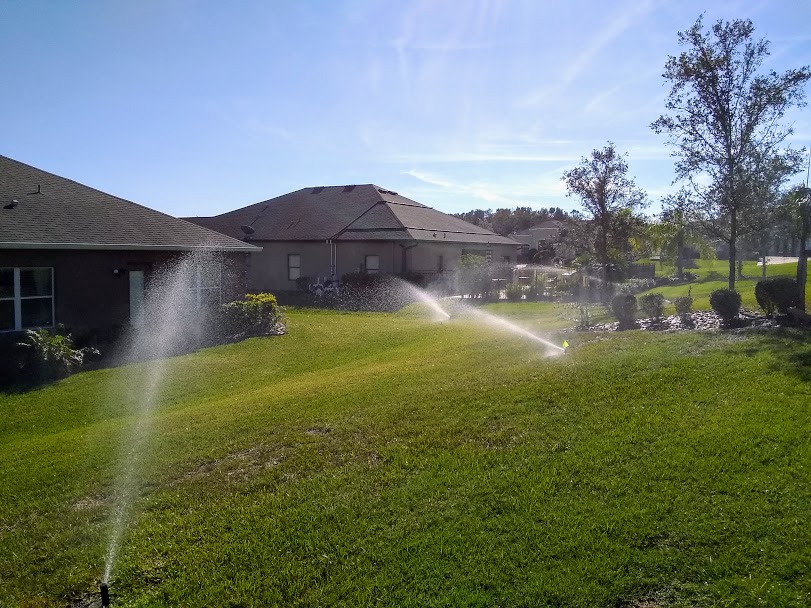Top 6 Most Common Causes Of Sprinkler Failure, A properly functioning sprinkler system is crucial for maintaining a healthy and beautiful lawn. However, there are several reasons why your sprinkler system may fail to work correctly. In this guide, we will explain the most common causes of sprinkler failure.
1. Clogged Nozzles or Sprinkler Heads
Over time, dirt, debris, and other small particles can accumulate inside the sprinkler nozzles or heads, causing them to clog. Clogged nozzles or heads can lead to uneven watering or low water pressure, resulting in a poorly maintained lawn.
2. Damaged Sprinkler Heads
Sprinkler heads can become damaged due to several reasons, including mowing, foot traffic, or even extreme weather conditions. A damaged sprinkler head can cause water to spray in the wrong direction or at the wrong angle, leading to wasted water and a poorly maintained lawn.
3. Broken Pipes or Valves
Pipes or valves that become damaged due to aging, shifting soil, or external damage can lead to leaks or complete failure of the sprinkler system. A broken pipe or valve can cause water to leak into the ground, leading to wasted water and even water damage to your property.
4. Electrical Problems
A sprinkler system relies on an electrical controller to turn on and off the water flow. Electrical issues, such as wiring problems or damaged electrical components, can cause the sprinkler system to fail.
5. Incorrect Water Pressure
If the water pressure in your sprinkler system is too high or too low, it can cause the sprinkler heads to malfunction or spray unevenly, resulting in a poorly maintained lawn.
6. Incorrectly Programmed Controller
If the sprinkler controller is programmed incorrectly or not at all, it can cause the system to water too much or too little, leading to a poorly maintained lawn.
There are several common causes of sprinkler failure that can impact the performance of your system. Regular maintenance and inspection of your sprinkler system can help prevent these issues and ensure that your lawn stays healthy and beautiful.
If you’re unsure or don’t feel confident in your ability to diagnose or fix the problem, it’s always best to seek the help of a professional sprinkler technician, like American Property Maintenance, for expert advice and assistance.

Top 6 Most Common Causes Of Sprinkler Failure How Do You Know If A Sprinkler Valve Is Bad
As a homeowner, it’s essential to maintain your sprinkler system to ensure that your lawn receives the right amount of water it needs to remain healthy and lush. One critical component of your sprinkler system is the valves.
Valves control the flow of water to different zones of your lawn, and when they malfunction, it can cause significant problems with your sprinkler system. We will discuss how to tell if your sprinkler valve is bad and what steps to take to fix it.
Signs of a Bad Sprinkler Valve
- Low water pressure: If you notice that your sprinkler system’s water pressure has decreased, it could be due to a bad valve. A faulty valve can restrict the water flow to your sprinkler heads, causing a weak spray pattern.
- Over-watered or under-watered areas: If you notice that some areas of your lawn are receiving too much water while others are not getting enough, it could be a sign of a faulty valve. A bad valve can cause one zone to receive too much water while another receives too little.
- Sprinkler head not popping up: If a sprinkler head in a particular zone is not popping up, it could be due to a faulty valve that is not allowing water to reach that zone.
Constantly running water: If you notice that your sprinkler system is running constantly, even when it’s not supposed to, it could be due to a bad valve that is not shutting off the water flow properly.
Steps to Fix a Bad Sprinkler Valve
- Identify the problem valve: The first step in fixing a bad sprinkler valve is to identify which valve is causing the problem. Look for any visible signs of damage or leaks around the valve.
- Check the wiring: If the valve is not opening or closing correctly, it could be due to faulty wiring. Check the wiring connections to ensure they are secure and not damaged.
- Clean or replace the valve: If the valve is dirty or clogged, it can cause it to malfunction. Clean the valve and check if it’s still functioning properly. If it’s not, consider replacing the valve.
- Call a professional: If you’re not comfortable with fixing the valve yourself, it’s best to call a professional sprinkler technician. They can diagnose and repair the problem quickly and efficiently, saving you time and frustration.
Top 6 Most Common Causes Of Sprinkler Failure, a bad sprinkler valve can cause significant problems with your sprinkler system, leading to wasted water and potential lawn damage. If you notice any of the signs mentioned above, take action to fix the problem promptly.
With proper maintenance and repair, your sprinkler system can continue to keep your lawn healthy and lush for years to come.

How To Replace A Sprinkler Diaphragm
Top 6 Most Common Causes Of Sprinkler Failure, Replacing a sprinkler diaphragm is an essential part of sprinkler system maintenance that you should know how to do as a homeowner. The diaphragm is a rubber membrane that controls the flow of water through the sprinkler valve. Over time, diaphragms can wear out or become damaged, causing the valve to malfunction.
This guide will explain the steps you need to follow to replace a sprinkler diaphragm.
Step 1: Turn off the Water Supply
Before you begin, you need to turn off the water supply to the sprinkler system. Locate the main shut-off valve and turn it off to prevent any water from flowing through the system while you’re working.
Step 2: Remove the Valve Cover
Once you’ve turned off the water supply, you can remove the valve cover by unscrewing the screws that hold it in place. Set the screws aside in a safe place, so you don’t lose them.
Step 3: Remove the Old Diaphragm
Locate the diaphragm inside the valve and carefully remove it from its position. Be careful not to damage the valve or the other components while you’re doing this. You can use a screwdriver to gently pry the diaphragm loose if it’s stuck.
Step 4: Install the New Diaphragm
Take your new diaphragm and align it with the valve so that the screw holes match up. Make sure that the diaphragm is positioned correctly before you screw it into place. Tighten the screws evenly to ensure that the diaphragm is properly secured.
Step 5: Reassemble the Valve
Once you’ve installed the new diaphragm, you can reassemble the valve by replacing the cover and tightening the screws back into place. Double-check to ensure that everything is correctly aligned and tightened.
Step 6: Turn on the Water Supply
Finally, you can turn on the water supply and test the valve to make sure that it’s working correctly. If you notice any leaks or other issues, you may need to make further adjustments or seek the help of a professional sprinkler technician.
Top 6 Most Common Causes Of Sprinkler Failure, Replacing a sprinkler diaphragm is a straightforward process you can do yourself with the right tools and basic knowledge. Follow the steps outlined in this guide, and you’ll be able to maintain your sprinkler system efficiently, saving you time and money in the long run.
If you have any questions or concerns, don’t hesitate to reach out to American Property Maintenance for expert advice and assistance.

Top 5 common symptoms of a bad solenoid
A sprinkler system is made up of several essential components that work together to distribute water evenly across your lawn. One of these components is the solenoid, a small electronic device that controls the flow of water through the valve. If the solenoid becomes faulty, it can lead to several symptoms that can impact the performance of your sprinkler system. In this guide, we will explain the common symptoms of a bad solenoid.
1. The valve Won’t Turn On
The most apparent symptom of a bad solenoid is that the valve won’t turn on. If you turn on the sprinkler system, but no water comes out, likely, the solenoid is not working correctly. This issue can be caused by a faulty wiring connection or a damaged solenoid.
2. The valve Won’t Turn Off
Another common symptom of a bad solenoid is that the valve won’t turn off. This issue is the opposite of the first symptom, where the valve won’t turn on. In this case, the valve remains open even after you turn off the sprinkler system. This problem can be caused by a damaged diaphragm or dirt and debris inside the valve.
3. Water Leaks
If you notice water leaking from around the valve, it could be a sign that the solenoid is not working correctly. A damaged solenoid can cause the valve to remain open, leading to water leaking out of the sprinkler system. If you notice any leaks, you should inspect the valve and solenoid for damage or wear and tear.
4. Irregular Sprinkler Pattern
If your sprinkler system is producing an irregular pattern or not covering the intended area, it could be a sign of a faulty solenoid. A bad solenoid can cause the valve to open and close irregularly, leading to an uneven distribution of water across the lawn.
5. Electrical Issues
Lastly, electrical issues can also be a sign of a bad solenoid. If you notice flickering lights or power outages when using the sprinkler system, it could be a sign of a damaged solenoid.
A bad solenoid can lead to several issues that can impact the performance of your sprinkler system. If you notice any of the above symptoms, you should inspect the valve and solenoid for damage or wear and tear.
If you’re unsure or don’t feel confident in your ability to diagnose or fix the problem, it’s always best to seek the help of a professional sprinkler technician, like American Property Maintenance, for expert advice and assistance.